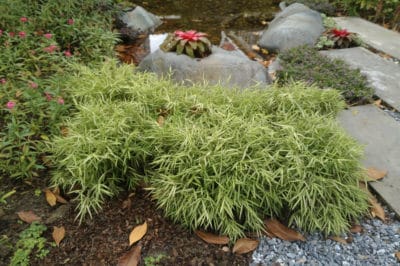About Bamboo
Bamboo originated primarily in tropical regions, although a few bamboo grow in temperate areas. The plant’s natural range varies from USDA Zones 5 to 10. The typical bamboo sends up multiple jointed stems during the growth period in early spring and summer. The fastest-growing plant in the world, mature bamboo can become literal giants in one year.
No Regrowth
Once a bamboo shoot, or culm, is cut it will not regrow. Unlike many shrubs and trees that respond to pruning by becoming bushier, bamboo may send up new culms, but it won’t become more dense. If you want your bamboo to take on the appearance of a bush, you must choose varieties carefully and trim properly.
Bamboo Groundcovers
Some bamboos are naturally low-growing. Since the leaves are on the top of the plant, this can make them look thicker and more like a bush. For example, pygmy bamboo may grow only 18 inches to three feet tall. If cut back to the ground at the end of winter, they will shoot up new growth in early spring, which helps them remain thick and dense.
Bamboo as Topiary
Some of the medium-height bamboos can be trained as topiary. However, they cannot be trained into fanciful shapes like box or other shrubs. To create topiary bamboo:
- Identify several stalks in the center of the clump as the “trunk.”
- Cut other stalks at ground level.
- Trim stems from the bottom half or two-thirds of the “trunk.”
- Cut off the top of the stem and shape the leaves.
When it’s Not a Bamboo
Nandina domestica – heavenly bamboo – is a garden shrub that is unrelated to true bamboo. However, it does have a similar appearance and also offers the benefit of bright red berries and colorful fall and winter foliage. You can prune to shape these plants and keep them bushy. Unlike true bamboo, they will regrow. Since they can be invasive, they are often grown in containers.
Lucky Bamboo
If you garden in USDA Zones 10 and 11, you may see a bushy plant about three to five feet tall that resembles bamboo. However, this is actually Draceana sanderiana, or lucky bamboo. It is used as a houseplant and in feng shui, and is one of the few plants that will grow in plain water indoors. Outdoors, it is often used in perennial beds or as a specimen plant.
